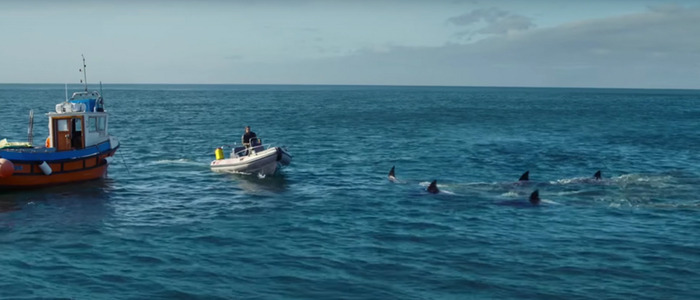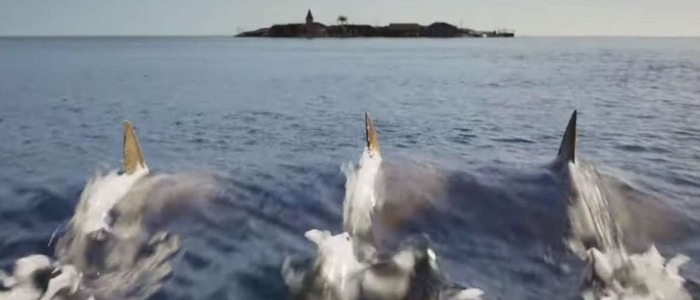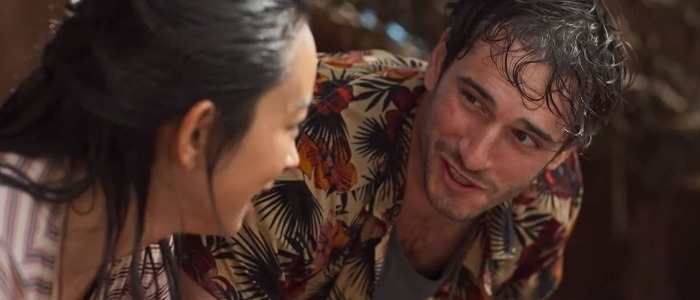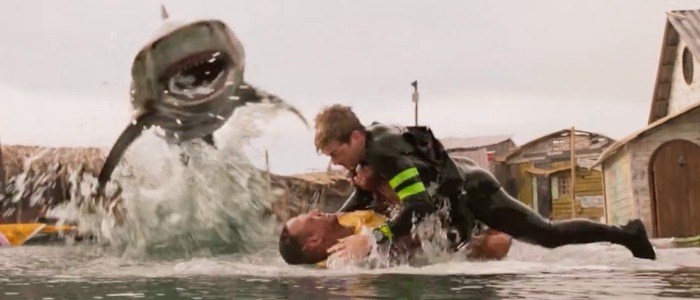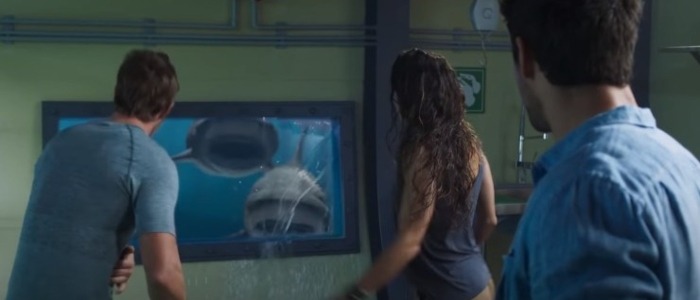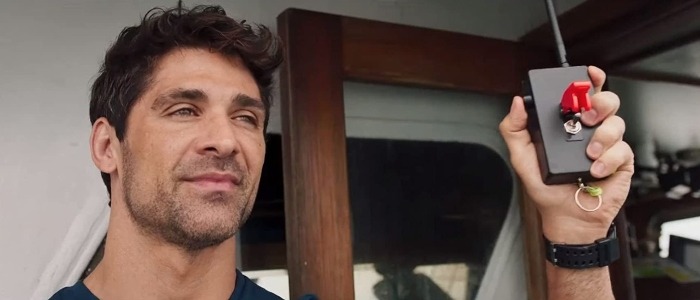'Deep Blue Sea 3' Is Leagues Above The Last Direct-To-Video Sequel
(Welcome to DTV Descent, a series that explores the weird and wild world of direct-to-video sequels to theatrically released movies. This week, we take a second dip into the world of 'Deep Blue Sea' sequels.)
I'm a sucker for killer shark movies, but the great ones represent a small percentage of the sub-genre overall. Most are dull, dumb, and waterlogged in their attempts to entertain and thrill, but none of those descriptors can be applied to Renny Harlin's 1999 gem, Deep Blue Sea. Okay, maybe it's a little dumb, but the film remains an absolute blast that entertains through to the very end.
The same cannot be said for the supremely disappointing direct to video sequel from 2018 – which I previously covered in this very column. It's a bland, uninteresting slog that never entertains or thrills, and it's the reason anticipation was kept in check when the inevitable second sequel was announced. The lack of title creativity felt like a bad sign, as even Twitter folks suggested the likes of Deep Blue 3ea, Deep Blue Three, and Deep Blue S3a, but I reluctantly dove into the deep end anyway and watched Deep Blue Sea 3.
And it is... good?
The Beginning
This is where I'd typically relate the plot of the original theatrical release, but seeing as Deep Blue Sea 3 is a follow-up to a previous DTV sequel, that's the synopsis I'll be sharing. Not coincidentally, the stories in the first and second films are the same. Deep Blue Sea 2 is centered on an underwater facility sitting deep on the ocean floor that's home to top-secret research involving shark intelligence. Trouble on the surface traps people below, and soon artificially enhanced sharks are making meals out of everyone they find. The only hope for containing the threat rests with a brilliant female scientist and a rugged shark wrangler, and yes, I'm still talking about Deep Blue Sea 2, not the original.
The group fights baby sharks below and the full grown smart sharks up on the surface, and the human cast is quickly turned into chum along the way. It ends as most movies about facilities on the ocean floor do – with the destruction of the lab. The survivors make their final stand, sharks are blown up off screen, and the world is safe once again from fish with higher IQs than you... but beneath the waves, a modified female and her new pups swim off into the darkness.
The DTV Plot
The island of Little Happy is a bit more depressing now as global warming and a rising ocean has left it abandoned. What was once a small fishing village built atop a coral reef with a vibrant community of two hundred is now devoid of human life. Well, nearly devoid, as Dr, Emma Collins leads a small team of researchers studying the effects of climate change on the area's sea life starting with the apex predator – Great White sharks. She's already noticed behavioral changes in the local shark population, but things worsen fast when a trio of bio-engineered bull sharks invade their ocean sanctuary.
Complicating things further is the arrival of a research vessel populated with underwater mercenaries sent to hunt the sharks which escaped from a lab (at the end of Deep Blue Sea 2). They've brought along a scientist of their own, but while they're happy killing the beasts, Dr. Richard Lowell is hoping to bring them in alive. Oh, and he's also Emma's ex which muddies the water a bit more. Caught between killer sharks and murderous thugs, Emma and her team – three assistants and two locals – are thrust into a fight for survival even more immediate than climate change.
Talent Shift
While Harlin's original is chock full with talent both on screen and off, the less than stellar Deep Blue Sea 2 is the inverse of that. From cast members you don't recognize to filmmakers whose previous highlight was something called Megachurch Murders, the film's IMDB page is far from inspiring.
This third film is actually several steps up from the last sequel when it comes to both cast and crew. Director John Pogue made his feature debut with another sequel (Quarantine 2: Terminal, 2011), but he then directed a wide theatrical release in 2014's The Quiet Ones. Coincidentally, writer Dirk Blackman also began his career with a sequel (Black Mask 2: City of Masks, 2002) before going on to write Outlander (2008) and Underworld: Rise of the Lycans (2009).
Cast members aren't exactly household names, but there are some possibly familiar faces in Tania Raymonde (Texas Chainsaw, 2013), Nathaniel Buzolic (Hacksaw Ridge, 2016), Emerson Brooks (Captain America: The Winter Soldier, 2014), and others. The performances are good, too, creating characters that engage viewers into caring what happens when they bite it by being bitten – some we're happy to see go, but we're pulling for a few others to live.
How the Sequel Respects the Original
It's working with a sliver of the budget afforded Harlin's film, but Deep Blue Sea 3 still manages to deliver a good looking movie filled with thrills, fun, and more. Gone are part two's dimly lit hallways and undersea antics as instead we return to action and shark shenanigans occurring in the bright of day. The island set has a real Waterworld (1995) feel to it, albeit on a much smaller scale, and it's a believable little respite atop the water. The sharks remain a threat, but when the hunters reveal their arsenal includes explosive-tipped bolts, it's clear that Little Happy's days are numbered. When we do go underwater, it's via well-shot sequences involving real sea life, and all of it works to complete the illusion.
The film aims for a similar mood to the first as it balances a straight thriller with some gleefully over the top death scenes. There's a nice homage to the original's most iconic death, a ridiculous beheading, and more. The first kill's reveal is pretty glorious in its pacing and visuals, and Pogue maintains that mix of tones throughout, alternating between explosive action, suspenseful chases, and more. We even get a solid fight scene in the middle of it all between two beefy guys intent on killing each other.
While the film never devolves into comedy or even approaches Sharknado-like nonsense, it manages to be a fun time even as it's playing things straight. One guy tells a shark to "Back the fuck off," and it does. Another worries that if these beasts escape and breed it could be the end of ocean life as we know it. "We're talking sea-rmageddon," he adds, and all you can do is nod in approval at the word play. One or two of the kills are guaranteed to make you vocal even if you're watching it alone, and that's no small feat.
How the Sequel S***s on the Original
Harlin's movie got by with mostly solid shark effects dampened only slightly by brief bouts of too-clear CG, but the first sequel relied solely on the latter. Crappy CG effects dominate part two, and while they're hardly the film's only problem, it remains an omnipresent one. Deep Blue Sea 3 once again relies on piss-poor CG to bring the sharks to life, and it's unfortunate as it's the only notable negative on display. It's especially egregious as the film features footage of plenty of real sharks and other fish which only serves to highlight how fake the animated ones look by contrast.
This is usually the bigger sections of this column, but the weak CG is really the only critical issue this third film has. Crazy, right?
Conclusion
I'm as surprised as anyone, but Deep Blue Sea 3 is good stuff. It's fun, exciting, well-acted, and looks good throughout (minus the aforementioned CG, obviously). The characters are engaging enough, and while the movie makes little effort to flesh them out too far, there's enough meat on their bones to give a damn. If your shark tastes run more serious and unnerving, you'll want to skip this and just re-watch The Reef (2010), but if you're craving some mildly cheesy fun in your animal-attack diet, this is the meal for you.

